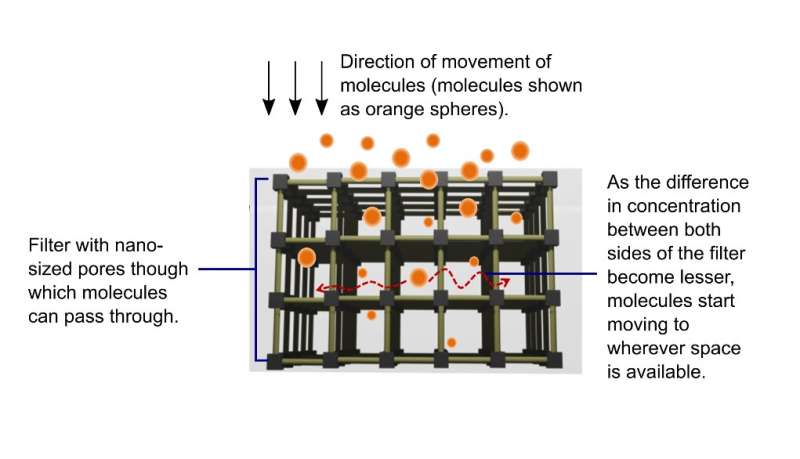This article has been reviewed according to Science X's editorial process and policies. Editors have highlighted the following attributes while ensuring the content's credibility:
fact-checked
peer-reviewed publication
trusted source
proofread
Study provides crucial insights on designing efficient nanofilters

The process of filtration makes an appearance in quite a few instances of our daily lives, for example: a strainer filtering out tea leaves while making a cup of tea. The tea leaves, being larger in size than the pores of the strainer, are unable to pass through and consequently get separated out from the hot brew.
Now, what if you had to filter out particles which are 107 to 108 times smaller than a tea leaf? Till recently, it was very challenging to make a strainer capable of filtering these nanoparticles. However, advances in chemical science and associated technology have equipped scientists across the world to build strainers that can separate molecules as small as hydrogen (~2*10-10 m).
In a recent study published in Nature Communications, Tanmoy Maity, Pratibha Malik, Ritesh Haldar and colleagues from the Tata Institute of Fundamental Research, Hyderabad (TIFRH), present a clearer picture of the movement of molecules through a strainer wherein the size of the pores can be reduced to Ångstrom (10-10 m) scale. The findings of this study opens up avenues for designing more efficient filtration processes frequently used in industries.
Molecular strainers are used in plastic, fuel and pharmaceutical industries to separate and purify small molecules, a step essential for manufacture of many products. At the molecular level, sieving is not as straightforward as filtering of tea leaves. Things get a bit more complicated as molecules interact with the material of the sieve, and the nature of this interaction becomes difficult to predict.
Further, the direction of the motion of molecules through the few Ångstrom (10-10 m) small sieves is very challenging to predict and visualize. A clearer understanding of such molecular motion would allow scientists to engineer molecular filters that can produce pure chemicals at a much lower cost than current methods.
Haldar and colleagues look at one particular molecular strainer, known as metal-organic framework (MOF) wherein size of the sieve can be tuned from 1-100 Ångstrom (10-10 m) scale, so that a specific molecule can be separated from a mixture based on its size. They have synthesized a thin film (~ 300 nm thickness) of this material, so that it can act as a filter. It was known that in presence of a gradient across the filter, molecules will move from a region where there is a higher concentration of molecules to a region of lower concentration.
The experimental observations from this TIFRH study indicate that as the concentration gradient becomes smaller, molecules move in a direction where space is available, even though that direction is orthogonal to the gradient.
The results of the study provides a new basis for designing filters with such small pore sizes, and opens up avenues for further explorations into their utilization for separating gases and ions.
More information: Tanmoy Maity et al, Chemically routed interpore molecular diffusion in metal-organic framework thin films, Nature Communications (2023). DOI: 10.1038/s41467-023-37739-8
Journal information: Nature Communications
Provided by Tata Institute of Fundamental Research



















